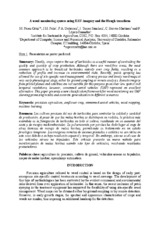Mostrar el registro sencillo del ítem
A weed monitoring system using UAV-imagery and the Hough transform
| dc.contributor.author | Pérez-Ortiz, María | |
| dc.contributor.author | Peña, J.M. | |
| dc.contributor.author | Gutiérrez, P.A. | |
| dc.contributor.author | Torres-Sánchez, J. | |
| dc.contributor.author | Hervás-Martínez, César | |
| dc.contributor.author | López-Granados, Francisca | |
| dc.date.accessioned | 2018-10-17T08:41:34Z | |
| dc.date.available | 2018-10-17T08:41:34Z | |
| dc.date.issued | 2015 | |
| dc.identifier.uri | http://hdl.handle.net/10396/17299 | |
| dc.description.abstract | Usually, crops require the use of herbicides as a useful manner of controlling the quality and quantity of crop production. Although there are weed-free areas, the most common approach is to broadcast herbicides entirely over crop fields, resulting in a reduction of profits and increase in environmental risks. Recently, patch spraying has allowed the use of site-specific weed management, allowing precise and timely weed maps at very early phenological stage, either by ground sampling or remote analysis. Remote imagery from piloted planes and satellites are not suitable for this purpose given their low spatial and temporal resolutions, however, unmanned aerial vehicles (UAV) represent an excellent alternative. This paper presents a new classification framework for weed monitoring via UAV showing promising results and accurate generalisation in different scenarios | es_ES |
| dc.description.abstract | Los cultivos precisan del uso de herbicidas para controlar la calidad y cantidad de producción. A pesar de que las malas hierbas se distribuyen en rodales, la práctica más extendida es la fumigación de herbicidas en todo el cultivo, resultando en un aumento del coste y de riesgos mediambientales. La pulvericación por parches ha dado lugar al auge de otras técnicas de manejo de malas hierbas, permitiendo su tratamiento en un estado fenológico temprano. Las imágenes remotas de aviones pilotados o satélites no son útiles en este caso debido a su baja resolución espacial y temporal. Sin embargo, este no es el caso de los vehículos aéreos no tripulados. Este artículo presenta un nuevo método para monitorización de malas hierbas usando este tipo de vehículos, mostrando resultados prometedores | es_ES |
| dc.format.mimetype | application/pdf | es_ES |
| dc.language.iso | eng | es_ES |
| dc.rights | https://creativecommons.org/licenses/by-nc-nd/4.0/ | es_ES |
| dc.subject | Precision agriculture | es_ES |
| dc.subject | Sunflower crop | es_ES |
| dc.subject | Unmanned aerial vehicles | es_ES |
| dc.subject | Weed mapping | es_ES |
| dc.subject | Machine learning | es_ES |
| dc.subject | Agricultura de precisión | es_ES |
| dc.subject | Cultivo de girasol | es_ES |
| dc.subject | Vehículos aéreos no tripulados | es_ES |
| dc.subject | Mapas de malas hierbas | es_ES |
| dc.subject | Aprendizaje automático | es_ES |
| dc.title | A weed monitoring system using UAV-imagery and the Hough transform | es_ES |
| dc.type | info:eu-repo/semantics/conferenceObject | es_ES |
| dc.relation.projectID | Gobierno de España. RECUPERA 2020 | es_ES |
| dc.relation.projectID | Gobierno de España. TIN2014-54583-C2-1-R | es_ES |
| dc.relation.projectID | Junta de Andalucía. P11-TIC-7508 | es_ES |
| dc.rights.accessRights | info:eu-repo/semantics/openAccess | es_ES |

